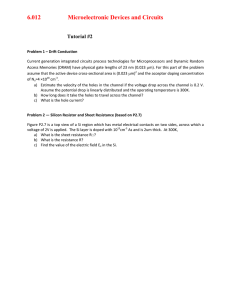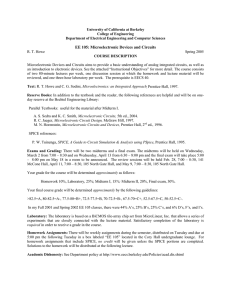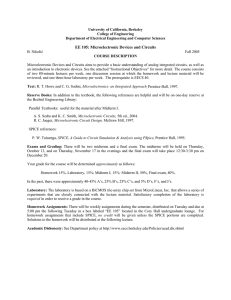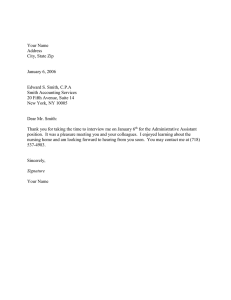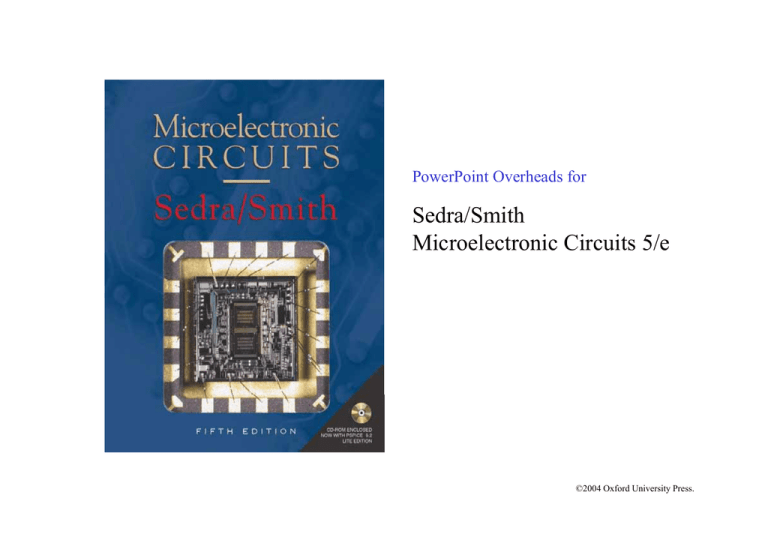
PowerPoint Overheads for
Sedra/Smith
S
d /S ith
Microelectronic Circuits 5/e
©2004 Oxford University Press.
Oxford University Press
Oxford New York
A kl d B
Auckland
Bangkok
k k B
Buenos Ai
Aires C
Cape Town
T
Chennai
Ch
i
Dar es Salaam Delhi Hong Kong Istanbul Karachi Kolkata
Kuala Lumpur Madrid Melbourne Mexico City Mumbai Nairobi
São Paulo Shanghai Taipei Tokyo Toronto
Copyright
py g © 2004 byy Oxford Universityy Press, Inc.
Published by Oxford University Press, Inc.
198 Madison Avenue, New York, New York 10016
www.oup.com
Oxford is a registered trademark of Oxford University Press
All rights reserved. No part of this publication may be reproduced,
stored in a retrieval system, or transmitted, in any form or by any means,
electronic, mechanical, photocopying, recording, or otherwise,
without the prior permission of Oxford University Press.
ISBN 0–19–517267–1
Printing number: 9 8 7 6 5 4 3 2 1
Printed in the United States of America
2
Introduction to Electronics
3
υ s ( t ) = Rs is ( t )
υ s (t ) = Rs is (t )
Figure 1.1 Two alternative representations of a signal source: (a) the Thévenin form, and (b) the Norton form.
Microelectronic Circuits - Fifth Edition
Sedra/Smith
Copyright © 2004 by Oxford University Press, Inc.
4
Figure 1.2 An arbitrary voltage signal vs(t).
Microelectronic Circuits - Fifth Edition
Sedra/Smith
Copyright © 2004 by Oxford University Press, Inc.
5
υ ( t ) = Va sin ω t
a
(1.1)
Figure 1.3 Sine-wave voltage signal of amplitude Va and frequency f = 1/T Hz. The angular frequency V = 2Pf rad/s.
Microelectronic Circuits - Fifth Edition
Sedra/Smith
Copyright © 2004 by Oxford University Press, Inc.
6
4V
1
1
(sin ω 0 t + sin 3ω 0 t + sin 5ω 0 t + ⋅ ⋅ ⋅)
υ(t) =
3
5
π
(1.2)
Figure 1.4 A symmetrical square-wave signal of amplitude V.
Microelectronic Circuits - Fifth Edition
Sedra/Smith
Copyright © 2004 by Oxford University Press, Inc.
7
Figure 1.5 The frequency spectrum (also known as the line spectrum) of the periodic square wave of Fig. 1.4.
Microelectronic Circuits - Fifth Edition
Sedra/Smith
Copyright © 2004 by Oxford University Press, Inc.
8
Figure 1.6 The frequency spectrum of an arbitrary waveform such as that in Fig. 1.2.
Microelectronic Circuits - Fifth Edition
Sedra/Smith
Copyright © 2004 by Oxford University Press, Inc.
9
Figure 1.7 Sampling the continuous-time analog signal in (a) results in the discrete-time signal in (b).
Microelectronic Circuits - Fifth Edition
Sedra/Smith
Copyright © 2004 by Oxford University Press, Inc.
10
Figure 1.8 Variation of a particular binary digital signal with time.
Microelectronic Circuits - Fifth Edition
Sedra/Smith
Copyright © 2004 by Oxford University Press, Inc.
11
D = b0 2 + b1 2 + b2 2 + ⋅ ⋅ ⋅ + bN −1 2
0
1
2
N −1
(1.3)
Figure 1.9 Block-diagram representation of the analog-to-digital converter (ADC).
Microelectronic Circuits - Fifth Edition
Sedra/Smith
Copyright © 2004 by Oxford University Press, Inc.
12
υ 0 ( t ) = Aυ i ( t )
(1.4)
Figure 1.10 (a) Circuit symbol for amplifier. (b) An amplifier with a common terminal (ground) between the input and output ports.
Microelectronic Circuits - Fifth Edition
Sedra/Smith
Copyright © 2004 by Oxford University Press, Inc.
13
υ0
Voltage gain (Aυ ) ≡
υI
(1.5)
Figure 1.11 (a) A voltage amplifier fed with a signal vI(t) and connected to a load resistance RL. (b) Transfer characteristic of a linear voltage amplifier
with
ith voltage
oltage gain Av.
Microelectronic Circuits - Fifth Edition
Sedra/Smith
Copyright © 2004 by Oxford University Press, Inc.
14
load power (PL )
Power gain (A p ) ≡
input power (PL )
υ 0 i0
=
υ I iI
i0
Current gain (A i ) ≡
iI
A p = Aυ A i
Microelectronic Circuits - Fifth Edition
Sedra/Smith
(1.6)
((1.7))
(1.8)
(1.9)
Copyright © 2004 by Oxford University Press, Inc.
15
Voltage
g ggain in decibels = 20 log
g Aυ
dB
Current gain in decibels = 20 log Aυ
dB
Power gain in decibels = 20 log Aυ
dB
Microelectronic Circuits - Fifth Edition
Sedra/Smith
Copyright © 2004 by Oxford University Press, Inc.
16
Pdc = V1 I1 + V2 I 2
η ≡
Pdc + PI = PL + Pdissipated
PL
× 100
Pd c
(1 .1 0 )
Figure 1.12 An amplifier that requires two dc supplies (shown as batteries) for operation.
Microelectronic Circuits - Fifth Edition
Sedra/Smith
Copyright © 2004 by Oxford University Press, Inc.
17
EXAMPLE 1.1
Input
9
= 9V/V
1
Aυ = 20 log9 ≅ 19.1 dB
Aυ =
Vi: 1V
Ii: 00.11 mA
Output
Vo: 9V
1 kΩ
Power Supply
±10V, 9.5 mA
∧
I0 =
9V
= 9mA
1kΩ
∧
Ai =
I0
∧
I0
=
9
= 90 A/A
01
0.1
A i = 20 log90 = 39.1 dB
PL = V0rms I 0rms =
PI = Virms I irms =
Microelectronic Circuits - Fifth Edition
Sedra/Smith
9
2
9
2
1 0.1
2
2
= 40.5 mW
= 0.05 mW
Copyright © 2004 by Oxford University Press, Inc.
18
Ap =
PL
40 5
40.5
=
= 810 W/W
0.05
PI
A p = 10 llog810
810 = 29
29.1
1 dB
Pdc = 10 × 9.5 + 10 × 9.5 = 190 mW
Pdissipated = Pdc + Pi - PL
= 190 + 0.05
0 05 - 40.5
40 5 = 149.6
149 6 mW
η =
Microelectronic Circuits - Fifth Edition
Sedra/Smith
PL
× 100 = 21.3 %
Pdc
Copyright © 2004 by Oxford University Press, Inc.
19
L−
Aυ
≤ υI
≤
L+
Aυ
Figure 1.13 An amplifier transfer characteristic that is linear except for output saturation.
Microelectronic Circuits - Fifth Edition
Sedra/Smith
Copyright © 2004 by Oxford University Press, Inc.
20
υ I ( t ) = VI + υ i ( t )
υ 0 ( t ) = V0 + υ 0 ( t )
υ I ( t ) = Aυυ i ( t )
dυ 0
Aυ =
dυ Ι
at Q
Figure 1.14 (a) An amplifier transfer characteristic that shows considerable nonlinearity. (b) To obtain linear operation the amplifier is biased as shown,
and the signal amplit
amplitude
de is kept small
small. Observe
Obser e that this amplifier is operated from a single power
po er supply,
s ppl VDD.
Microelectronic Circuits - Fifth Edition
Sedra/Smith
Copyright © 2004 by Oxford University Press, Inc.
21
EXAMPLE 1.2
-11 40υ Ι
υ 0 = 10 - 10 e
(1
(1.11)
11)
υ Ι = 0.690 V
L+ = 10 - 10-11 10 V
VI = 0.673 V
Aυ = -200 V
Microelectronic Circuits - Fifth Edition
Sedra/Smith
Copyright © 2004 by Oxford University Press, Inc.
22
Figure 1.15 A sketch of the transfer characteristic of the amplifier of Example 1.2. Note that this amplifier is inverting (i.e., with a gain that is negative).
Microelectronic Circuits - Fifth Edition
Sedra/Smith
Copyright © 2004 by Oxford University Press, Inc.
23
Figure 1.16 Symbol convention employed throughout the book.
Microelectronic Circuits - Fifth Edition
Sedra/Smith
Copyright © 2004 by Oxford University Press, Inc.
24
RL
υ 0 = Aυ oυ i
RL + Rυ
υ0
RL
Aυ ≡
= Aυ o
υi
RL + R0
Ri
υ i = υs
Ri + Rs
(1.13)
(1
(1.12)
12)
υ0
Ri
RL
= Aυ o
υs
Ri + Rs RL + R0
Figure 1.17 (a) Circuit model for the voltage amplifier. (b) The voltage amplifier with input signal source and load.
Microelectronic Circuits - Fifth Edition
Sedra/Smith
Copyright © 2004 by Oxford University Press, Inc.
25
Figure 1.18 Three-stage amplifier for Example 1.3.
Microelectronic Circuits - Fifth Edition
Sedra/Smith
Copyright © 2004 by Oxford University Press, Inc.
26
EXAMPLE 1.3
υι 1
1 MΩ
=
= 0.909 V/V
υ s 1 MΩ + 100 kΩ
Aυ 1 ≡
υi 2
100 kΩ
= 10
= 9.9 V/V
υi1
100 kΩ + 1 kΩ
Aυ 2 ≡
υi 3
10 kΩ
= 100
= 90.9 V/V
υi 2
10 kΩ + 1 kΩ
Aυ 3 ≡
υL
100 Ω
=1
= 0.909 V/V
100 Ω + 10 Ω
υi 3
Aυ ≡
υL
= Aυ 1Aυ 2 Aυ 3 = 818 V/V
υi1
Microelectronic Circuits - Fifth Edition
Sedra/Smith
Copyright © 2004 by Oxford University Press, Inc.
27
υ L υ L υ i1
υ
=
= Aυ i 1
υ s υ i1 υ s
υs
= 818 × 0.909
0 909 = 743.6
743 6 V/V
Ai ≡
i 0 υ L 100Ω
=
i i υ i 1 1 MΩ
= 104 × A υ = 8.18 × 106 A/A
Ap ≡
PL υ L i 0
=
PI υ i 1 i i
= A υ A i = 818 × 8.18 × 106 =66.9 × 108 W/W
A p (dB) =
1
⎡ A (dB) + A i (dB)⎤⎦
2⎣ υ
Microelectronic Circuits - Fifth Edition
Sedra/Smith
Copyright © 2004 by Oxford University Press, Inc.
28
Microelectronic Circuits - Fifth Edition
Sedra/Smith
Copyright © 2004 by Oxford University Press, Inc.
29
Aυο
⎛ Ro ⎞
= A is ⎜
⎟
R
⎝ i⎠
Aυο = Gis Ro
Aυο
Rm
=
Ri
Microelectronic Circuits - Fifth Edition
Sedra/Smith
(1.14)
(1.15)
(1.16)
Copyright © 2004 by Oxford University Press, Inc.
30
Figure 1.19 (a) Small-signal circuit model for a bipolar junction transistor (BJT). (b) The BJT connected as an amplifier with the emitter as a common
terminal bet
between
een input
inp t and ooutput
tp t (called a common-emitter
common emitter amplifier).
amplifier) (c) An alternative
alternati e small
small-signal
signal circuit
circ it model for the BJT
BJT.
Microelectronic Circuits - Fifth Edition
Sedra/Smith
Copyright © 2004 by Oxford University Press, Inc.
31
EXAMPLE 1.4
rπ
υ be = υ s
rπ + Rs
(1 17)
(1.17)
υ o = − gmυ be (RL ro )
(1
(1.18)
18)
υo
rπ
=−
gm (RL ro )
υs
rπ + Rs
(1
(1.19)
19)
υo
25
2.5
=−
× 40 × ( 5 100 )
υs
2.5 + 5
= − 63.5
63 5 V/V
Microelectronic Circuits - Fifth Edition
Sedra/Smith
Copyright © 2004 by Oxford University Press, Inc.
32
υo
2.5
−
× 40 × 5
υs
2.5 + 5
= − 66.7 V/V
β i = gmυ be
b
β = gm rπ
β = 40 mA/V × 2.5 kΩ
= 100 A/A
Microelectronic Circuits - Fifth Edition
Sedra/Smith
Copyright © 2004 by Oxford University Press, Inc.
33
Figure E1.20
Microelectronic Circuits - Fifth Edition
Sedra/Smith
Copyright © 2004 by Oxford University Press, Inc.
34
Vo
T (ω ) =
Vi
∠T (ω ) = φ
Figure 1.20 Measuring the frequency response of a linear amplifier. At the test frequency V, the amplifier gain is characterized by its magnitude (Vo/Vi)
and phase F.
Microelectronic Circuits - Fifth Edition
Sedra/Smith
Copyright © 2004 by Oxford University Press, Inc.
35
To (ω )
T (ω ) =
Ti (ω )
To ( s )
T ( s) =
Ti ( s )
Figure 1.21 Typical magnitude response of an amplifier. |T(V)| is the magnitude of the amplifier transfer function—that is, the ratio of the output
Vo(V) to the input Vi(V).
)
Microelectronic Circuits - Fifth Edition
Sedra/Smith
Copyright © 2004 by Oxford University Press, Inc.
36
Figure 1.22 Two examples of STC networks: (a) a low-pass network and (b) a high-pass network.
Microelectronic Circuits - Fifth Edition
Sedra/Smith
Copyright © 2004 by Oxford University Press, Inc.
37
Figure 1.23 (a) Magnitude and (b) phase response of STC networks of the low-pass type.
Microelectronic Circuits - Fifth Edition
Sedra/Smith
Copyright © 2004 by Oxford University Press, Inc.
38
Figure 1.24 (a) Magnitude and (b) phase response of STC networks of the high-pass type.
Microelectronic Circuits - Fifth Edition
Sedra/Smith
Copyright © 2004 by Oxford University Press, Inc.
39
Figure 1.25 Circuit for Example 1.5.
Microelectronic Circuits - Fifth Edition
Sedra/Smith
Copyright © 2004 by Oxford University Press, Inc.
40
EXAMPLE 1.5
Zi
Vi = Vs
Z i + Rs
Vi = Vs
1
1 + RsYi
1
= Vs
1 + Rs ⎡⎣(1 / Ri ) + sC i ⎤⎦
Vi
1
=
Vs 1 + ⎡⎣( Rs / Ri ) + sC i Rs ⎤⎦
Vi
1
1
=
Vs 1+( Rs / Ri ) 1 + sC i ⎡⎣( Rs Ri ) /( Rs + Ri )⎤⎦
Microelectronic Circuits - Fifth Edition
Sedra/Smith
Copyright © 2004 by Oxford University Press, Inc.
(1.20)
41
Vo = µ Vi
RL
RL + Ro
Vo
1
1
1
=µ
Vs
1+( Rs / Ri ) 1+( Ro / RL ) 1 + sC i ⎡⎣( Rs Ri ) /( Rs + Ri )⎤⎦
Rs Ri
τ = Ci
= C i ( Rs // Ri )
Rs + Ri
(1.22)
Vo
1
1
( s = 0) = µ
K≡
Vs
1 + ( Rs / Ri ) 1 + ( Ro / RL )
ω0 =
1
τ
=
1
C i ( Rs // Ri )
Microelectronic Circuits - Fifth Edition
Sedra/Smith
(1.21)
(1.23)
((1.24))
Copyright © 2004 by Oxford University Press, Inc.
42
1
1
K = 144
= 100 V/V
1 + (20 / 100) 1 + (200 / 100)
ω0 =
1
60pF × (20kΩ//100kΩ )
1
6
=
=
10
rad/s
-12
3
60 × 10 × (20 × 100 /(20 + 100)) × 10
106
= 159.2kHz
f0 =
2π
Vo
100
( jω ) =
T ( jω ) ≡
Vi
1 + j (ω / 106 )
Microelectronic Circuits - Fifth Edition
Sedra/Smith
Copyright © 2004 by Oxford University Press, Inc.
43
υ 0 ( t ) = 10sin10
10 i 102 t , V
υ 0 ( t ) = 9.95sin(105 t − 5.7° ), V
υ 0 ( t ) = 7.07 sin(106 t − 45° ), V
T 1 and φ = − tan -1 100 = −89.4°
υ 0 ( t ) = 0.1sin(108 t − 89.4° ), V
Microelectronic Circuits - Fifth Edition
Sedra/Smith
Copyright © 2004 by Oxford University Press, Inc.
44
Figure 1.26 Frequency response for (a) a capacitively coupled amplifier, (b) a direct-coupled amplifier, and (c) a tuned or bandpass amplifier.
Microelectronic Circuits - Fifth Edition
Sedra/Smith
Copyright © 2004 by Oxford University Press, Inc.
45
Figure 1.27 Use of a capacitor to couple amplifier stages.
Microelectronic Circuits - Fifth Edition
Sedra/Smith
Copyright © 2004 by Oxford University Press, Inc.
46
Figure E1.23
Microelectronic Circuits - Fifth Edition
Sedra/Smith
Copyright © 2004 by Oxford University Press, Inc.
47
Figure 1.28 A logic inverter operating from a dc supply VDD.
Microelectronic Circuits - Fifth Edition
Sedra/Smith
Copyright © 2004 by Oxford University Press, Inc.
48
NH H = VOH − VIH
(1.25)
NM L = VIL − VOL
(1.26)
Figure 1.29 Voltage transfer characteristic of an inverter. The VTC is approximated by three straightline segments. Note the four parameters of the VTC
(VOH, VOL, VIL, and VIH) and their use
se in determining the noise margins (NMH and NML).
)
Microelectronic Circuits - Fifth Edition
Sedra/Smith
Copyright © 2004 by Oxford University Press, Inc.
49
NH H = NM L = VDD /2
(1.27)
Figure 1.30 The VTC of an ideal inverter.
Microelectronic Circuits - Fifth Edition
Sedra/Smith
Copyright © 2004 by Oxford University Press, Inc.
50
Figure 1.31 (a) The simplest implementation of a logic inverter using a voltage-controlled switch; (b) equivalent circuit when vI is low; and (c)
eq i alent circuit
equivalent
circ it when
hen vI is high
high. Note that the sswitch
itch is ass
assumed
med to close when
hen vI is high.
high
Microelectronic Circuits - Fifth Edition
Sedra/Smith
Copyright © 2004 by Oxford University Press, Inc.
51
Figure 1.32 A more elaborate implementation of the logic inverter utilizing two complementary switches. This is the basis of the CMOS inverter studied
in Section 4.10.
4 10
Microelectronic Circuits - Fifth Edition
Sedra/Smith
Copyright © 2004 by Oxford University Press, Inc.
52
Figure 1.33 Another inverter implementation utilizing a double-throw switch to steer the constant current IEE to RC1 (when vI is high) or RC2 (when vI is
lo ) This is the basis of the emitter
low).
emitter-coupled
co pled logic (ECL) st
studied
died in Chapters 7 and 11.
11
Microelectronic Circuits - Fifth Edition
Sedra/Smith
Copyright © 2004 by Oxford University Press, Inc.
53
Pdynamic = ffCV
2
DD
((1.28))
y( t ) = Y∞ − (Y∞ − Y0+ )e
Microelectronic Circuits - Fifth Edition
Sedra/Smith
− t /τ
Copyright © 2004 by Oxford University Press, Inc.
(1.29)
54
Figure 1.34 Example 1.6: (a) The inverter circuit after the switch opens (i.e., for t ≥ 0+). (b) Waveforms of vI and vO. Observe that the switch is assumed
to operate instantaneously.
instantaneo sl vO rises exponentially,
e ponentiall starting at VOL and heading toward
to ard VOH .
Microelectronic Circuits - Fifth Edition
Sedra/Smith
Copyright © 2004 by Oxford University Press, Inc.
55
EXAMPLE 1.6
VOL = Voffset +
= 0.1+
VDD − Voffset
Ron
R+R on
5 − 0.1
× 0.1 = 0.55 V
1.1
.
υ 0 ( t ) = 5 − (5 − 0.55)e − t / τ
1
2
1
= (5 − 0.55)
0 55)
2
= 0.69τ = 0.69 RC
υ 0 ( t PLH ) = (VOH + VOL )
t PLH
= 0.69
0 69 × 103 × 10−11
= 6.9 ns
Microelectronic Circuits - Fifth Edition
Sedra/Smith
Copyright © 2004 by Oxford University Press, Inc.
56
Figure 1.35 Definitions of propagation delays and transition times of the logic inverter.
Microelectronic Circuits - Fifth Edition
Sedra/Smith
Copyright © 2004 by Oxford University Press, Inc.
57
Figure P1.6
Microelectronic Circuits - Fifth Edition
Sedra/Smith
Copyright © 2004 by Oxford University Press, Inc.
58
Figure P1.10
Microelectronic Circuits - Fifth Edition
Sedra/Smith
Copyright © 2004 by Oxford University Press, Inc.
59
Figure P1.14
Microelectronic Circuits - Fifth Edition
Sedra/Smith
Copyright © 2004 by Oxford University Press, Inc.
60
Figure P1.15
Microelectronic Circuits - Fifth Edition
Sedra/Smith
Copyright © 2004 by Oxford University Press, Inc.
61
Figure P1.16
Microelectronic Circuits - Fifth Edition
Sedra/Smith
Copyright © 2004 by Oxford University Press, Inc.
62
Figure P1.17
Microelectronic Circuits - Fifth Edition
Sedra/Smith
Copyright © 2004 by Oxford University Press, Inc.
63
Figure P1.18
Microelectronic Circuits - Fifth Edition
Sedra/Smith
Copyright © 2004 by Oxford University Press, Inc.
64
Figure P1.37
Microelectronic Circuits - Fifth Edition
Sedra/Smith
Copyright © 2004 by Oxford University Press, Inc.
65
Figure P1.58
Microelectronic Circuits - Fifth Edition
Sedra/Smith
Copyright © 2004 by Oxford University Press, Inc.
66
Figure P1.63
Microelectronic Circuits - Fifth Edition
Sedra/Smith
Copyright © 2004 by Oxford University Press, Inc.
67
Figure P1.65
Microelectronic Circuits - Fifth Edition
Sedra/Smith
Copyright © 2004 by Oxford University Press, Inc.
68
Figure P1.67
Microelectronic Circuits - Fifth Edition
Sedra/Smith
Copyright © 2004 by Oxford University Press, Inc.
69
Figure P1.68
Microelectronic Circuits - Fifth Edition
Sedra/Smith
Copyright © 2004 by Oxford University Press, Inc.
70
Figure P1.72
Microelectronic Circuits - Fifth Edition
Sedra/Smith
Copyright © 2004 by Oxford University Press, Inc.
71
Figure P1.77
Microelectronic Circuits - Fifth Edition
Sedra/Smith
Copyright © 2004 by Oxford University Press, Inc.
72
Figure P1.79
Microelectronic Circuits - Fifth Edition
Sedra/Smith
Copyright © 2004 by Oxford University Press, Inc.
73
Table 1.1 The Four Amplifier Types
Microelectronic Circuits - Fifth Edition
Sedra/Smith
Copyright © 2004 by Oxford University Press, Inc.
74

